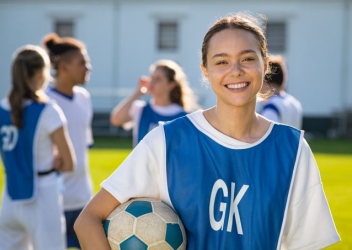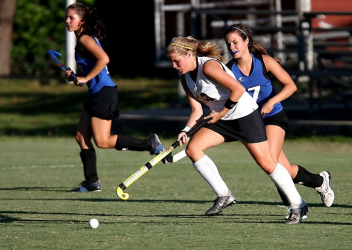Research In Action
Research In Action
Breadcrumb

As the pro football season wraps up on Feb. 11, everyone gets their refreshments, finds their favorite place to watch a game, and settles in for the showdown. The Super Bowl starts at kickoff with countless phone camera lights and cheers. Amongst the players, there are feelings of passion for the game, excitement, and invincibility.
As an athletic trainer, I know how quickly that invincible feeling can change to one of vulnerability and confusion when a serious injury occurs.
The biggest game of the year can serve as a reminder that an initial response to those occurrences, as we’ve seen in highly-publicized injuries and medical incidents in recent past, can make all the difference. For example, when Buffalo Bills safety Damar Hamlin sustained a hit that stopped his heart in January 2023 during an NFL game, the quick actions of athletic trainers and sports medicine personnel saved his life. Much like how the timing and accuracy of the initial response was crucial for Damar Hamlin, the prompt recognition and diagnosis of a traumatic brain injury (TBI) is just as critical.
Objectivity When You Suspect a Concussion
The initial response to suspected concussion and traumatic brain injury (TBI) is not always as straightforward and precise as it was in the Hamlin scenario. Individualized and varied responses are key drivers of a concussion-injured player’s symptoms, recovery time, and even potential risk for long-term health complications.
Whether it is the biggest game of the year or the first game of a high school season, it’s important to note that there are reasons why an athlete may not report what is being felt when there’s concern about concussion. The athlete may not want to let down teammates, coaches, family, friends, or even oneself. There’s often a lack of knowledge about the potential dangers of continuing to play with a concussion. Even money has a role if the athlete has the potential for scholarships heading into college.
The NFL has a robust protocol in place to protect both their athletes and sports medicine personnel in cases of suspected concussion. To improve objectivity, the NFL hired independent neurologists unaffiliated with either team to conduct independent exams to evaluate players with a suspected concussion.
Outside of the NFL, athletic trainers and medical providers should be on the lookout for potential biases when it comes to concussion diagnosis and recovery. The athlete’s health should always come first.
Pressure to keep an athlete on the field can come from many sources, including the athlete. The player may attempt to make their case to stay in the game. In the case of concussion, we must consider that these individuals are potentially impaired (physically, cognitively, emotionally, or otherwise) and unable to make well-informed and decisions regarding their health.
Similarly, pressure from parents and coaches might weigh on a decision. Thus, the responsibility falls on the medical expert to do what’s best for the athlete’s health.
Your Objective Assessment Tools
While subjective symptom reporting is still the best diagnostic tool for concussion, the diagnostic process can be enhanced by including objective assessments like those seen in the SCAT-6. This includes an immediate assessment/neurologic screen, observable signs (either witness or on video), use of the Glasgow Coma Scale, a Cervical Spine Assessment, Coordination and Ocular/Motor Screen & Assessment, and a Memory Assessment, all followed by a more in-depth cognitive assessment. Across areas of practice at CHOP, the use of the visio-vestibular exam has been successful in identifying patients at higher risk for developing prolonged symptoms.
If you’re planning on tuning in, be sure to enjoy the game, and consider these points about concussion to help guide recognition and diagnosis for sports-related concussion.



